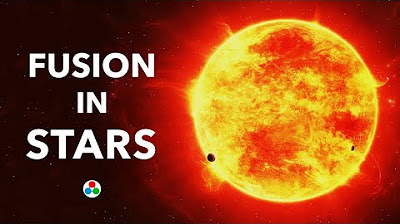What's Inside The Sun?
Summary
TLDRThis video explores the Sun's mysteries, revealing its energy source as nuclear fusion of hydrogen into helium. It delves into the Sun's life cycle, the enigma of its hotter corona, and the powerful effects of solar flares on Earth, including the awe-inspiring auroras. The script also humorously considers the hypothetical scenario of slicing the Sun, highlighting the catastrophic consequences for our solar system.
Takeaways
- 🌞 The Sun is a G-type yellow dwarf star, relatively small compared to other stars, with a temperature of 15 million degrees Celsius.
- 🔥 The Sun's energy comes from nuclear fusion, where hydrogen atoms are fused to form helium, a process that will continue for another 4.5 billion years.
- 🌐 The Sun's corona is mysteriously hotter than its surface, with temperatures exceeding 300 times that of the surface, a phenomenon not yet fully understood by scientists.
- 💥 Nanoflares, small solar explosions, occur in the Sun's atmosphere millions of times per second, contributing to the high temperature of the corona.
- 🌌 Solar flares are massive releases of energy from the Sun, affecting Earth's electromagnetic spectrum and classified into X, M, and C classes based on their intensity.
- ❄️ X-class solar flares can cause severe disruptions, including global radio blackouts and interference with communication systems.
- 🌀 M-class flares may cause brief blackouts in polar regions, while C-class flares are usually unnoticeable to Earth.
- 🌌 Auroras, or polar lights, are indirectly caused by solar flares through coronal mass ejections (CMEs) interacting with Earth's atmosphere.
- 🛠️ The thought experiment of slicing the Sun would require tools capable of withstanding its extreme temperature, which do not currently exist.
- ☢️ If the Sun were to be sliced, Earth would be exposed to harmful gamma radiation and experience a drastic drop in temperature, leading to an 'eternal winter'.
- 💥 The loss of a significant portion of the Sun's mass would disrupt the solar system, potentially causing planets to change orbits and collide with each other.
Q & A
What is the primary source of the Sun's energy and heat?
-The primary source of the Sun's energy and heat is nuclear fusion, a process where hydrogen atoms fuse to form helium, releasing energy in the process.
What type of star is the Sun classified as?
-The Sun is classified as a 'G-type' yellow dwarf star, indicating it is relatively small in size compared to other stars and has a yellowish color.
What is the estimated age of the Sun?
-Scientists have estimated the age of the Sun to be around 4.5 billion years old.
What is the temperature of the Sun's core?
-The temperature of the Sun's core is approximately 15 million degrees Celsius (27 million degrees Fahrenheit).
Why is the Sun's corona hotter than its surface?
-The reason behind the Sun's corona being hotter than its surface is still a mystery, but one hypothesis involves 'nanoflares', small explosions in the Sun's atmosphere that release a significant amount of energy.
What are solar flares and how do they affect Earth?
-Solar flares are sudden flashes of increased brightness on the Sun's surface, releasing energy across the electromagnetic spectrum. They can cause radio blackouts, interfere with communications, and affect power grids on Earth.
How are solar flares categorized based on their energy output?
-Solar flares are categorized into three classes based on their energy output: 'X-class flares' which are the most energetic and cause the most significant effects on Earth, 'M-class flares' which are medium-sized, and 'C-class flares' which have the least energy and are usually unnoticeable.
What are the potential consequences of slicing a piece of the Sun?
-Slicing a piece of the Sun would lead to harmful radiation exposure, a deadly drop in Earth's temperature, unpredictable solar activity, and potential disruption of the solar system's orbits, possibly causing massive collisions.
What is the role of the Sun in maintaining the structure of the solar system?
-The Sun, accounting for 99.8 percent of the solar system's mass, keeps all the planets, dwarf planets, asteroids, and other objects in precise orbits, maintaining harmony and stability within the solar system.
How do solar flares contribute to the creation of auroras on Earth?
-Solar flares can produce 'coronal mass ejections' (CMEs), which are combinations of radiation and particles. When these interact with gases in Earth's atmosphere, they excite the gases, leading to the beautiful northern and southern polar lights, or auroras.
What are the different colors of auroras caused by?
-The different colors of auroras are caused by the interaction of CMEs with different gases in Earth's atmosphere. Oxygen produces greenish-yellow or red light, while nitrogen produces blue light.
Outlines

This section is available to paid users only. Please upgrade to access this part.
Upgrade NowMindmap

This section is available to paid users only. Please upgrade to access this part.
Upgrade NowKeywords

This section is available to paid users only. Please upgrade to access this part.
Upgrade NowHighlights

This section is available to paid users only. Please upgrade to access this part.
Upgrade NowTranscripts

This section is available to paid users only. Please upgrade to access this part.
Upgrade Now5.0 / 5 (0 votes)





